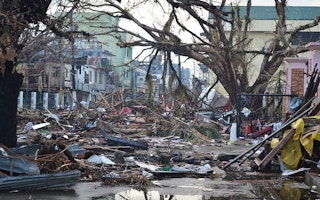From protecting coastal slum dwellers on Pacific islands against floods to helping poor farmers keep up harvests battered by drought in Africa, a global fund to help developing countries adapt to climate change received a vote of confidence at the latest round of U.N. climate talks.
At the end of the two-week meeting in Bonn, which ran over into Saturday morning, governments agreed the Adaptation Fund will become one of the formal tools to meet the goals of the Paris climate accord - a decision needed to ensure the fund’s continuing existence.
Victor Viñas, vice-chair of the fund’s board from the Dominican Republic, said the move would “benefit many more vulnerable communities” in the developing nations it serves.
The Adaptation Fund began operating a decade ago under the Kyoto Protocol, the world’s earlier treaty to tackle global warming, which is intended to run until 2020.
A levy on a Kyoto Protocol carbon trading mechanism generated almost $200 million for the fund, but that income declined as carbon prices fell, and government donors have stepped up with contributions in recent years.
They did so again in Bonn, with Germany, Sweden, Belgium’s Wallonia region, Italy and Ireland helping the Adaptation Fund raise more than $93 million this year, exceeding its annual goal of $80 million, which will rise to $100 million next year.
“This financial institution provides critical support to help developing countries manage climate impacts,” said Paula Caballero, head of the World Resources Institute climate programme, noting those impacts will intensify as the planet warms.
Adaptation experts say the fund has proven its worth to climate-hit communities over its 10-year existence - albeit with modest resources.
“The Adaptation Fund has developed some very interesting and innovative practices,” said Saleemul Huq, director of the Dhaka-based International Centre for Climate Change and Development.
It has allocated $462 million for projects and related activities in 73 developing countries, which are now benefiting nearly 5.5 million people directly.
“
This financial institution provides critical support to help developing countries manage climate impacts.
Paula Caballero, head, World Resources Institute climate programme
Nearly all of its projects cost less than $10 million, with some receiving as little as $10,000 to $30,000.
But that has allowed it to pioneer ways of managing scarce water supplies or growing food in forests at the local level where it matters most, say its supporters.
And it has done so partly by channelling money to approved government agencies and environmental organisations in developing countries, enabling them to take the reins and boosting their ability to handle larger amounts of climate finance.
Michael Kracht, an official with Germany’s environment ministry who chairs the Adaptation Fund Board, said the fund’s projects had “performed pretty well” and it was learning how to improve as climate adaptation needs on the ground evolve.
A key challenge now is to find more stable sources of income, so the fund no longer needs to go “begging” to donors each year, he added.
Money “mismatch”
This year alone, the Adaptation Fund said it received a record 54 project proposals valued at $350 million, “reflecting the rising seas, increasing floods, droughts and intense storms occurring throughout the world”.
It decided to back more than $104 million in new proposals. But even with its annual fundraising target more than met, it cannot finance everything in its pipeline.
“There is a big demand, which the Adaptation Fund could respond to as long as there is enough money,” Kracht told the Thomson Reuters Foundation.
The details of how the fund will operate under the Paris Agreement are due to be worked out at U.N. climate talks in a year’s time. Meanwhile it remains unclear whether, or how, the linkage will bring a more secure stream of cash.
One option is for the fund to tap the much larger pot of its younger sister, the Green Climate Fund (GCF). That fund has secured pledges of more than $10 billion, although there are doubts over whether the United States will deliver $2 billion of that.
Adaptation expert Huq argues that connecting the two funds would make sense, not least because the GCF has been slow to get money “out of the door” to vulnerable nations.
“The GCF has money it can’t spend. The Adaptation Fund has projects ready to go, but it doesn’t have money. So that is a mismatch,” he said on the sidelines of the talks in Bonn.
Potential legal issues could be ironed out if there were political will to bring the two funds together, he added.
This story was published with permission from Thomson Reuters Foundation, the charitable arm of Thomson Reuters, that covers humanitarian news, women’s rights, trafficking, property rights, climate change and resilience. Visit http://news.trust.org)










